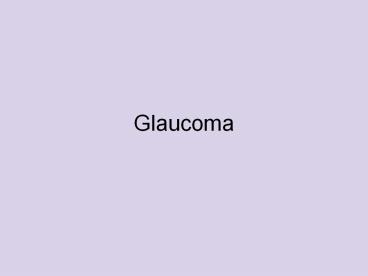Glaucoma - PowerPoint PPT Presentation
Title:
Glaucoma
Description:
Glaucoma Intraocular pressure is determined by a balance between production and removal of aqueous humor Aqueous is actively secreted into the posterior chamber by ... – PowerPoint PPT presentation
Number of Views:259
Avg rating:3.0/5.0
Title: Glaucoma
1
Glaucoma
2
(No Transcript)
3
- Intraocular pressure is determined by a balance
between production and removal of aqueous humor - Aqueous is actively secreted into the posterior
chamber by the ciliary process (non-pigmented
epithelium), by a combination of active transport
and ultrafiltration - Filtration As blood flows in the ciliary body's
capillaries, it is coarsely filtered by the
capillaries' endothelial cells. The resulting
plasma is then refiltered by the pigmented and
nonpigmented ciliary epithelial cells and is
secreted into the posterior chamber
4
- Active transport occurring in the nonpigmented
cilary epithelial cells induces small osmotic
pressure gradients in between the cells. A higher
concentration of solutes in the proximal part of
the intercellular space generates a flow of
water. The concentration diminishes from the
proximal part to the distal part, releasing the
liquid into the posterior chamber - It then passes through the pupil into the
anterior chamber and leaves the eye predominantly
through the conventional pathway
5
Conventional Pathway
- Aqueous humor exits the eye through
the trabecular meshwork into Schlemm's canal - It flows through 2530 collector canals into the
episcleral veins to reach the bloodstream - The greatest resistance to aqueous flow is
provided by the trabecular meshwork, and this is
where most of the aqueous outflow occurs - Damage here raises the resistance and increases
IOP in primary open angle glaucoma
6
Uveoscleral Pathway
- A small proportion of the aqueous (4) drains
across the ciliary body into the supra-choroidal
space - It is then absorbed into the venous circulation
7
Intraocular Pressure
- Intraocular pressure is determined by a balance
between production and removal of aqueous humor - Normal range 10 - 21 mmHg
- Hypotony is defined as intraocular pressure equal
to or less than 5 mmHg which could indicate fluid
leakage and deflation of the eyeball - IOP decreases at night due to the slower
production of aqueous humor - Raised IOP causes mechanical damage to the axons
- Raised IOP also causes ischemia of the axons by
reducing blood flow at the nerve head
8
Goldman Tonometer
9
- against anesthesized cornea
- fluorescein is applied in the tear film
- 2 hemicircles are seen by the examiner
- force of contact is increased until the inner
borders of the hemicircles just touch - endpoint - the endpoint at which a fixed amount of the
cornea is achieved
10
Perimeter
11
- accurate plotting of the visual field
- kinetic VF - patient indicates when he first sees
a light of a specific size and brightness brought
in from the periphery - static VF - patient indicates when he first sees
a stationary light of increasing brightness,
presented anywhere in the visual field - useful in chronic ocular and neurological
conditions, to monitor changes in the visual field































